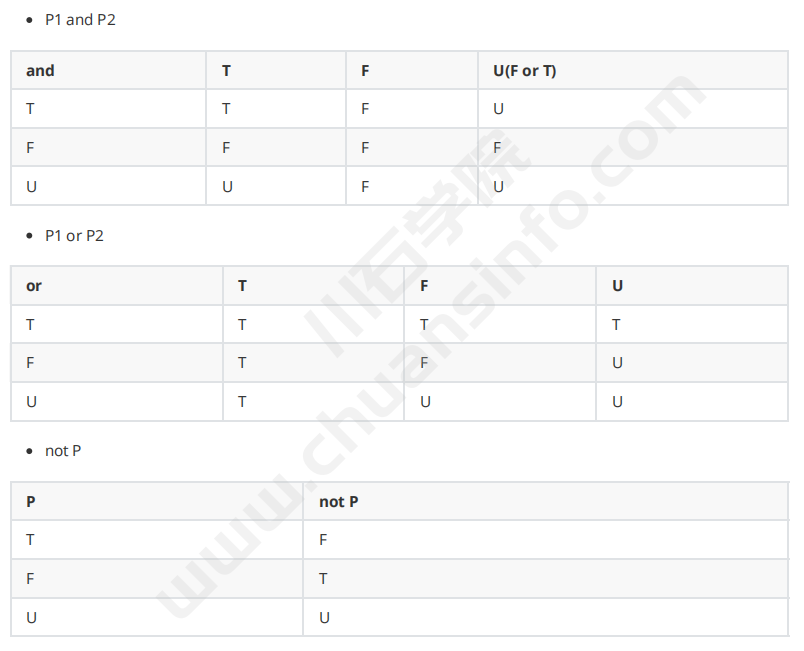一天一个关于测试知识点,5分钟内讲解你最关心的软件测试问题,今天就接着来谈谈关于软件测试中的“ 数据查询语言DQL数据过滤语法及实例”。

数据过滤
是由where子句来实现的.
语法:
select list
from tabs
where search_conditions;
▲ 原理
where 条件
谓词 --> true 表示满足条件 返回数据行
-->false 表示不满足条件 丢弃数据行
-->unknown 表示不满足条件 丢弃数据行
where 多个条件
复合谓词: 基本谓词通过逻辑运算符连接起来的式子
逻辑运算符: and or not
复合谓词经过逻辑运算 --> true false unknown
1、基本谓词
比较谓词
比较两个值表达式返回的值的大小关系是否成立.
where ve1 VS ve2
ve1 or ve2: 值表达式(value expression),凡是能返回某个值的式子
# 1 --> 1 常量
# 1 + 2 --> 3 常量表达式
# ecs_goods.market_price --> 每一行返回一个值 列引用
# market_price * 1.2 --> 每一行返回一个计算后的值 计算列
空行
VS: 关系运算符
> < >= <= = !=(or<>)
#比较谓词的否定是通过关系运算符取反来实现的
<= >= < > != =
▲ 数据库查找数据的方式
a.全表扫描
从表中的第一行按照顺序一直查找到最后一行.
b.索引扫描
按照表建立起来的索引查找数据.
#找出市场价格大于1000的商品信息
SELECT goods_id, goods_name, market_price
FROM ecs_goods
WHERE market_price > 1000;
○ 范围谓词
判断值表达式返回的值是否在一个区间范围内.
where ve between ve1 and ve2
where ve not between ve1 and ve2
between ve1 and ve2: 定义一个闭区间范围[ve1,ve2]
# ve >= ve1 and ve <= ve2
#找出市场价格在1400到2400之间的商品信息
SELECT goods_id, goods_name, market_price
FROM ecs_goods
WHERE market_price BETWEEN 1400 AND 2400;
○ 集合成员谓词
判断值表达式返回的值是否是一个指定集合中的一个元素.
where ve in (ve1,ve2,...,ven)
where ve not in (ve1,ve2,...ven)
(ve1,ve2,...,ven): 定义了一个n个元素的集合(元素无序,唯一)
#ve = ve1 or ve = ve2 or ... or ve = ven
#找出市场价格是50,100,150,200的商品信息
SELECT goods_id, goods_name, market_price
FROM ecs_goods
WHERE market_price IN (50,100,150,200);
○ 模式匹配谓词
判断值表达式返回的值是否与一个指定的字符串相匹配
where ve like 'str'
where ve not like 'str'
str: 指定要匹配的字符串
str = 必须匹配的字符 + 可以忽略的字符
普通字符 通配符
#通配符: 具有特殊含义的字符,可以描述或匹配多个字符,in MySQL
% 匹配任意字符串(包含空串) name like '李%'
_(下划线) 匹配任意单个字符 name like '李_' 姓李单名
#找出商品名称包含诺基亚的商品信息
SELECT goods_id, goods_name, market_price
FROM ecs_goods
WHERE goods_name LIKE '%诺基亚%';
#找出商品名称只有4个字符的产品信息
SELECT goods_id, goods_name, market_price
FROM ecs_goods
WHERE goods_name LIKE '____';
○ 空值谓词
判断值表达式返回的值是否是一个空值.
where ve is null
where ve is not null
▲ 空值
表示没有或未知.在数据库中用null表示.
不等同于0
#找出没有设置密码提示问题用户信息
SELECT *
FROM ecs_users
WHERE passwd_question IS NULL;
▲ not关键字
当谓词的条件难以描述时,可以写出其相反的条件,再使用not关键字进行否定.
#找出设置了密码提示问题用户信息
SELECT *
FROM ecs_users
WHERE passwd_question IS NOT NULL;
2、逻辑运算符
● and
逻辑"与", 双目运算符
P1 and P2 --> true
true true
当前仅当所有的谓词返回true时,复合谓词结果才为true.
这意味着所有的条件要同时成立.
#商品类型为9中市场价格大于500的产品信息
SELECT goods_id, goods_name, goods_type, market_price
FROM ecs_goods
WHERE goods_type = 9 AND market_price > 500;
● or
逻辑"或", 双目运算符
P1 or P2 --> true
\true/
只要谓词之一返回true时,复合谓词结果则为true.
这意味着只要多个条件中的某一个成立即可.
#商品类型为9,或者市场价格大于500的产品信息
SELECT goods_id, goods_name, goods_type, market_price
FROM ecs_goods
WHERE goods_type = 9 OR market_price > 500;
● not
逻辑"非", 单目运算符
not P
true --> false
false --> true
unknown --> unknown
#市场价格不大于500的商品信息
SELECT goods_id, goods_name, goods_type, market_price
FROM ecs_goods
WHERE NOT market_price > 500;
● 混合运算
#运算符优先级:
() > not > and > or
not P1 or P2 and P3
s1. not P1 --> r1
s2. P2 and P3 --> r2
s3. r1 or r2 --> r
(not P1 or P2) and P3
s1. not P1 --> r1
s2. r1 or P2 --> r2
s3. r2 and P3 --> r
3、运算规则
▲ unknown的由来
where ve1 VS ve2
ve1 or ve2 返回的值为null,则比较谓词的结果为unknown
#找出没有设置密码提示问题用户信息
SELECT *
FROM ecs_users
WHERE passwd_question = NULL; # error, use is null
▲ 真值表
true --> T
false --> F
unknown --> U
